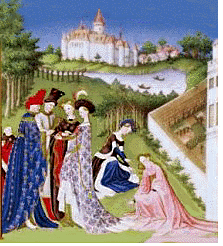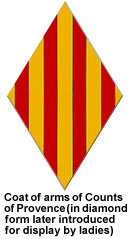...Best of Sicily presents... Best of Sicily Magazine. ... Dedicated to Sicilian art, culture, history, people, places and all things Sicilian. |
by Vincenzo Salerno | ||
Magazine Index Best of Sicily Arts & Culture Fashion Food & Wine History & Society About Us Travel Faqs Contact Map of Sicily |
Raymond of Provence ruled what was nominally a piece of the Holy Roman Empire having ties to Aragon and Catalonia. Following his death, Provence became a fief of Raymond's Angevin son-in-law Charles I of Naples and Sicily, though it was later annexed to the Kingdom of France. Raymond's wife, and the mother of his four daughters, was the ambitious Beatrice, daughter of Thomas I of Savoy. Within a decade following the death of Frederick II (and extinction of his Hohenstaufen line at the hands of Charles), Sicily fell under Angevin rule until, in 1282, the bloody Vespers uprising brought it into the Aragonese sphere of influence. (Steven Runciman's Sicilian Vespers, which presents the details and chronology of this history, would serve as a good reference for anybody seeking background to Goldstone's book.) Raymond himself was not particularly endeared to the Aragonese, having spent a few years imprisoned in a castle in Aragon following the death of his father (Alfonso II of Provence), and finally escaping in 1219. Yet Raymond was, in fact, a grandson of the King of Aragon Alfonso II (1152-1196) and a first cousin, one generation removed, of King Peter III of Aragon (1236-1285) who assumed the Sicilian crown following the Vespers in 1282, thus openly contesting Charles's rights in Sicily. The dynasty of the Counts of Provence may have been one of Europe's "minor" houses (Savoy and Toulouse also come to mind), but it was not without significance. Nancy Goldstone's book is hardly the first to bring to our attention the importance of women's roles in medieval Europe, but the position of four sisters as powerful queen-consorts is unique in the history of the Middle Ages. Cunning and intelligent, each of the four exercised her greatest influence as the mother of a future king but also participated in historic events. All four wed as teenagers. Margaret (1221-1295) wed Louis IX at just thirteen
and eventually accompanied him on two crusades, actually ransoming him from
the Mamluks during the first one. Eleanor (1223-1291) married Henry III
of England, and Sanchia (1228-1261) All the sisters were attractive, Sanchia perhaps most of all, but Beatrice inherited more than beauty. Her father made this youngest daughter his heir. In light of subsequent events, it would not be overstatement to suggest that Charles relied upon the wealth of Provence to conquer Sicily and southern Italy from Frederick's young heirs. Without such resources he might have failed. Such was the challenge of travel of the time, even for royalty, that only on a few occasions were all four sisters united in adulthood; they all met, joined by their mother, in Paris late in 1254. On that occasion the elder, widowed Beatrice and her three older daughters seemed envious of Little Beatrice's inheritance. Human nature has changed little in seven centuries, but perhaps we shouldn't judge the ladies too harshly. It would be difficult not to envy a little sister who has inherited an entire French county. Beatrice of Savoy, the mother of the four queens, died in 1266. The narrative is lively but never too informal. Here is a history in the passionate, popular tradition of John Julius Norwich and Steven Runciman. Though it is not the book's focus, Sicily is woven as a common thread throughout Four Queens. Each of the queens left a familial legacy through children. What is implicit throughout the book is that the reader is witness to the height of the Middle Ages, a period whose fullness would really survive only a single century beyond 1300. By the time of the Battle of Agincourt (1415) technology was already changing the face of warfare, and hence kingship and knighthood, while the rise of the Medici family was fostering the budding Italian Renaissance that would challenge medieval concepts of art, music, philosophy and even life itself. The fall of Constantinople (1453) signalled the last breath of a colorful era, and changing roles for European queens and kings. Jealousies, envy and bitchy cattiness round out the tale of the four sisters and their power-hungry mother. Maps, genealogical charts and a reading list lend the book an ample historical context. This is popular history at its best, accurate but endlessly fascinating. It's clear that Goldstone has done her homework; her research in original sources is superb. She is that rarity of rarities: a true historian. A book like Four Queens brings history alive as no work of "historical fiction" ever could. The story of these four sisters helps to complete the complex story of the High Middle Ages not only in Sicily but in crusading --and conniving-- Europe. About the Author: Palermo native Vincenzo Salerno has written biographies of several famous Sicilians, including Frederick II and Giuseppe di Lampedusa. | |
Top of Page |
 A new book tells us something about the happenings of thirteenth-century
Sicily (and mainland Italy), France, Germany and England from the perspective of the four sisters married to the
kings who ruled these distinct --but strangely connected-- regions. Nancy
Goldstone's Four Queens - The Provençal Sisters Who Ruled Europe
recounts the story of the four daughters of Raymond-Berengar IV (1198-1245),
Count of Provence. Each married a man who was to become an important sovereign.
A new book tells us something about the happenings of thirteenth-century
Sicily (and mainland Italy), France, Germany and England from the perspective of the four sisters married to the
kings who ruled these distinct --but strangely connected-- regions. Nancy
Goldstone's Four Queens - The Provençal Sisters Who Ruled Europe
recounts the story of the four daughters of Raymond-Berengar IV (1198-1245),
Count of Provence. Each married a man who was to become an important sovereign. wed his younger brother Richard,
Earl of Cornwall and later King of the Romans (Germans). Beatrice (1231-1267),
later to reveal herself as the most ambitious of the four, married Charles
of Anjou long before it was known that he would become King Charles I of
Sicily, cornerstone of the kingdom he was to rule from Naples.
wed his younger brother Richard,
Earl of Cornwall and later King of the Romans (Germans). Beatrice (1231-1267),
later to reveal herself as the most ambitious of the four, married Charles
of Anjou long before it was known that he would become King Charles I of
Sicily, cornerstone of the kingdom he was to rule from Naples.